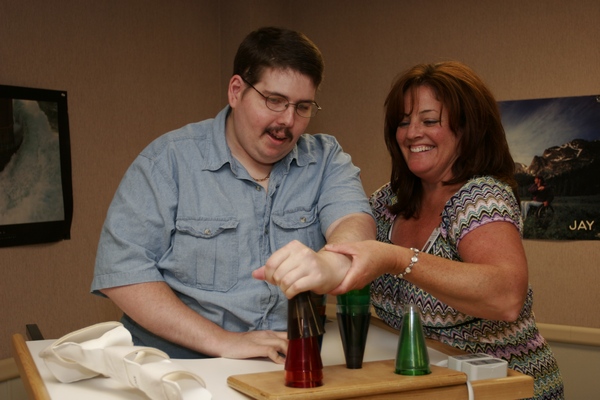Neuro Developmental Treatment (NDT) Techniques
History
- Developed by Berta Bobath, PT and Karel Bobath, MD for functional recover
- Main patient populations include: adult CVA/hemiplegia, and Cerebral Palsy
Theoretical Framework
NDT as a neuromuscular and functional reeducation technique now includes neuroplasticity as a basis how the brain can change and reorganize itself and its processes based on practice and experience
- facilitation of normal postural alignment and movement patterns
- demand should be placed on the involved side during developmental and functional activities
- sensory feedback (manual contact, visual integration, somatosensory reinforcement) is essential to recovering function
- treatment includes looking at the whole person and specific functional needs; recovery vs. compensation
|
Individualized Functional Outcomes |
Patient: Life role, supports systems, home environment, patient's goals ICF: Pathologies, abilities, limitations |
|
Motor Control |
Optimize use of systems (sensory, musculoskeletal) and available movement patterns/synergies |
|
Target the Involved Side |
Progressive, increased demand and functional use |
|
Motor Learning |
Closed vs. open environment, simple vs. complex, part vs. whole, practice and feedback/knowledge of results
|
|
Team-Approach |
Coordination with rehab team, parents/caregivers, and support staff to allow for continual practice and consistent use of facilitation strategies |
Essentials for Treatment Effectiveness
- therapists must be able to observe and distinguish normal from abnormal alignment and movement patterns
- therapists must be able to make the functional retraining activities meaningful to the patient; task specific
- therapists must be able to select the optimal practice method, feedback, and environment for maximum function and independence
- therapists must have stable footwear, good flexibility in lumbar spine and lower extremities for optimal body mechanics during mat activities.
http://www.stonecrestmedical.com/CPM/Neuro_Ball.jpg
|
Alignment
|
Cannot impose normal movement on malaligned joints
|
|
Handling
|
Inhibition, Facilitation, Key points
|
|
Placing
|
Assisting patients in achieving the appropriate
|
Alignment Check points - PTs and PTAs use manual contact to establish, align and assist the patient with these key elements

- Base of support - wide, narrow, staggered, asymmetrical
- Body segment alignment - synergies, compensatory head and trunk position
- Muscle activation - pattern and timing of movement during functional activities
- Weight shift - in all planes
Functional Check points - PTs and PTAs will modify manual cues and feedback to the demands of the task and the ability of the patient. Examples of functional check points include:
- Gravity
- Levers
- Time
- Distance
- Speed
- Environment
http://www.mitaka-supply.com/02en_models/102m165/p2.gif
|
Starting Posture |
Missing Components |
Manual Cues |
|
Begin and assess the most efficient posture from which to move (typically upright) Reorient to midline (head/trunk) Neutral alignment of body segments
|
Observe starting posture and make comparisons to normal Review the evaluation and POC for PT assessment of primary impairments (e.g. decreased ROM, strength, sensation, control) Select a movement-based functional intervention which progresses patient toward mobility goals |
Use hands on key points of control to facilitate normal posture/movement and inhibit abnormal posture/movement May includes manual stretching if PT has determined ROM/muscle length interferes with function |

http://www.wingatehealthcare.com/images/location_photos/worcester/img11.jpg
Example of NDT Techniques
toc | return to top | previous page | next page


